It ain’t over ’til the fat man stops singing
Remembering legendary singer and musician Fats Domino
By Wanda Potrykus
They call, they call me the fat man
‘Cause I weigh two hundred pounds
All the girls they love me
‘Cause I know my way around
The Fat Man, Fats Domino, 1949
We are all seemingly aware of the adage, “It ain’t over ’til the fat lady sings”, since it is employed ad infinitum on many occasions and many of us, myself included, may have always thought it originated as a quote referring to the final (in)famous aria of Richard Wagner’s famous, if somewhat lengthy, Ring Cycle (Der Ring des Nibelungen), which ends after 14 hours with the often hefty and very large bosomed battle ready, sword and shield in hand Valkyrie called Brunnhilde in horned helmet lamenting the end of the world (the Norse Gods’ world that is) for upwards of 10 plus minutes. In fact, her farewell immolation scene lasts almost twenty minutes and leads directly to the finale of Wagner’s interminable magnum opus.
I, however, have always thought it was based on a much older saying, its origins lost in time but seemingly that is not strictly the case. It appears the much quoted adage, in its present form at least, dates only from the mid-1970s and its first use was, in fact, not in reference to opera at all but to the ending of a sports game. Confused? Yes, I was too, until I found a very convincing explanation that traces the antecedents of the phrase, which can be found it all its various permutations on a very handy internet site called The Quote Investigator, which for those interested in the origins of words and sayings is well worth a read, if only to find out how mistaken we have been.
“You were my thrill”
Nevertheless, when and wherever it originated, it is now very firmly part of our present day lexicon of colloquialisms and we continue to cheerfully trot it out ad nauseum, as my misappropriation of it will indicate, except for the fact that I am using it in reference to the recent demise of a famous Rock ‘n’ Roll great, Antoine ‘Fats’ Domino, who sadly for us, will be penning and performing no more songs, having passed on to that Great Blueberry Hill located somewhere, one would hope, in rock music heaven.
‘My dream came true / The wind in the willow played / Love’s sweet melody / But all of those vows you made / Were never to be / Though we’re apart / You’re part of me still / For you were my thrill / On Blueberry Hill’
Blueberry Hill, Fats Domino, Recording artist 1956; Songwriters, Al Lewis, Larry Stock, Vincent Rose
For unfortunately for us, on October 24, 2017, Antoine Dominique Domino Jr. stopped singing, playing the piano and shake, rocking and rolling in the good times and the bad forever. The legendary “fat man” of my youth was dead.
“R.I.P. Fats. You will be missed”
“The reports of my death are exaggerated.”
– Samuel Clemens aka Mark Twain, London, UK, May 31, 1897
Like Mark Twain (whose famous ‘death’ quote has also been badly misquoted almost from day one) leading him to write in his book Following the Equator, published in November 1897, “It is my belief that nearly any invented quotation, played with confidence, stands a good chance to deceive.”
This time though, we should believe that the announcement made by Domino’s family is the definitive one, since although reports of Fats Domino’s death had already surfaced in the aftermath of Hurricane Katrina in 2005, when it was claimed he had died in the deluge when his mansion was destroyed, they were not correct.
In fact, he had been rescued from the roof of his home in the Lower 9th Ward together with his frail wife Rosemary (her failing health the reason they had stayed at home and not evacuated earlier), and had ended up in a shelter in Baton Rouge, where one of their daughters later located them, but not before announcements of his demise had reverberated across the airwaves.
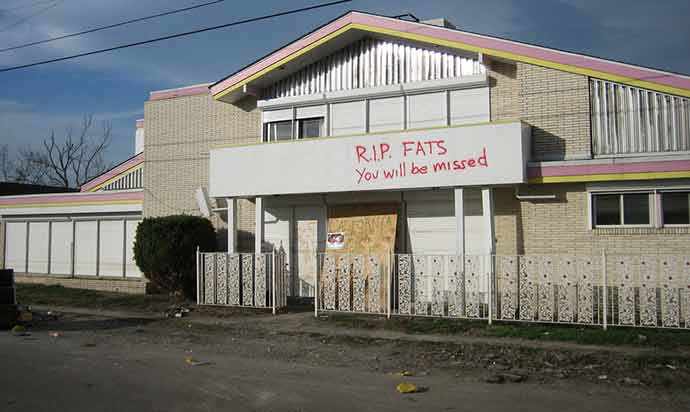
Fats Domino’s mansion in New-Orleans – Image: Infrogmation of New Orleans via StockPholio.net
With Domino erroneously presumed dead in the confusion, graffiti had been sprayed on his home:
“R.I.P. Fats. You will be missed.”
– Graffiti scrawled on the ruins of the Domino mansion after the ravages of Hurricane Katrina
Nevertheless, in order to help fellow musicians, who had been wiped out (as he was) and to put the news of his ‘untimely’ death in perspective, he wrote some new songs and participated in a benefit concert. He also released a new album (his first for many years), a portion of the sales of which were donated to the Tipitina Foundation to be used to help impoverished musicians and to help restore New Orleans’ musical culture. The album was entitled Alive and Kickin’.
‘All over the country, people wanna know / Whatever happened to Fats Domino? / I’m alive and kickin’.’
Alive and Kickin’, Fats Domino, 2007
One among the many legendary jazzmen nicknamed ‘Fats’
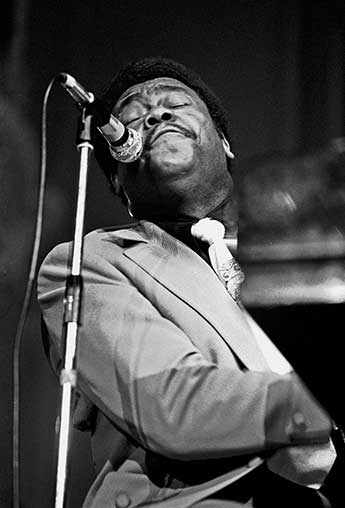
Image: Heinrich Klaffs
“I knew Fats from hanging out at a grocery store. He reminded me of Fats Waller and Fats Pichon. Those guys were big names and Antoine – that’s what everybody called him then – had just got married and gained weight. I started calling him ‘Fats’ and it stuck.”
Billy Diamond, New Orleans’ Bassist and Bandleader
In the music scene of fifty to a hundred or so years ago ‘Fats’ seems to be an appellation that denoted affection rather than a slur, which, with our current ongoing emphasis on being slim and skinny, it has become today. However, in the early to mid 20th century ‘Fats’, as well as “Fat boy”, “Fat girl” (i.e. two names often given to Fats Navarro due to his high pitched voice) were hung on to musicians’ names more as terms of endearment, such as in the case of Fats Waller, Fats Pichon, Fats Navarro and, of course, Fats Domino who, although he is mostly acclaimed as one of the early rock ‘n’ roll ‘greats’ (being one of the first inductees into the Rock ‘n Roll Hall of Fame) has his roots firmly grounded in the boogie-woogie piano playing of the early 20th century jazz keyboardists.
“Even if Fats didn’t actually invent rock’n’roll, he was certainly responsible for accidentally inventing ska, and thus reggae. Just check out the offbeats in Be My Guest. Along with putting a Crescent City bounce to an old cowboy song, Blueberry Hill, and the groundbreaking Fat Man, Antoine ‘Fats’ Domino was definitely a great innovator, and richly deserves a much fatter entry in the history books.”
Michael Gray, The Guardian, UK, October 25, 2017
As his extensive musical repertoire indicates, since Domino’s name is also attached to the roots of Jamaican ska and early reggae, his music and music making belongs to and crosses into several disparate musical genres – ragtime, jazz, jump blues, jelly roll, bebop, swing, rock, rhythm and blues, pop, ska, reggae, country. In fact, one of his most well-known and iconic recordings, Blueberry Hill, is a variation on a country ‘n’ western song recorded in 1940 by Gene Autry and again in 1949 by Louis Armstrong, although Fats Domino’s version is the one most remember the best.
‘There would have been no rock n’ roll, Jamaican ska, or rocksteady, had it not been for the major influence of Fats Domino.’
Damien Jurado, songwriter, October 25, 2017
10 facts you may not know about Antoine ‘Fats’ Domino
- He was 5 feet 3 inches tall, and in 1949 weighed 220 lbs.
- His first solo song The Fat Man issued in 1949, at the age of 21, sold over a million copies, rose as high as #2 on the R&B charts, an unheard feat for a black musician at that time in history.
- His music literally broke down the colour barriers since at his concerts the dancing couples, who at the start were segregated by ropes, but seemingly throughout the evening the crush of the crowd pushed down the barriers between white and black teenagers so, by the end of his high energy performances, everyone was dancing together.
- In 2005, his version of Blueberry Hill was chosen to be listed in the US National Recording Registry.
- In December 2010, he was No. 25 on the Rolling Stone magazine’s list of 100 Greatest Artists. He sold an unbelievable 106 million recordings.
- He married Rosemary Hall in August 1948 and they were married for almost 60 years until she died in April 2008.
- He built his white mansion, trimmed in pink, yellow and lavender with its double front doors that opened into an atrium with chandeliers hanging from the ceiling and ivory dominos set in a white marble floor in New Orleans’ Lower 9th Ward where, with Rosemary, he raised his eight children, who were all given names beginning with ‘A’.
- He was an extremely shy, somewhat introverted, hometown New Orleans’ boy who did not like to tour, and for much of the latter part of his life played in and around New Orleans and lived off the royalties from his songs.
- He continued, up until the age of 67, to perform his famous “piano push” (where he stood up and while continuing to play, pushed his grand piano around, and sometimes right off the stage, with his stomach). The last ‘recorded’ time was in 1995, when on a UK tour with Chuck Berry and Little Richard, and while performing this signature style trick in Sheffield, England, he collapsed and was taken to hospital with severe chest spasms.
- He inspired countless recording artists including Elvis Presley, Bob Dylan, The Beatles, The Rolling Stones, Elton John, Randy Newman, LL Cool J, Kid Rock, and many of his piano riffs became rock ‘n roll standards, plus his iconic flat-topped haircut, which gave his face its famous ‘cube’ shape, finally became fashionable 30 years after he pioneered the signature Domino ‘look’.
Looking for a well-researched and written biography of Fats D?
“Blue Monday how I hate blue Monday / Got to work like a slave all day / Here come Tuesday oh hard Tuesday / I’m so tired, got no time to play / Here come Wednesday / I’m beat to my socks / My girl called, got to tell her that I’m out / Cos Thursday is a hard workin’ day / And Friday I’ll get my pay /
Saturday mornin’, oh Saturday mornin’ All my tiredness have gone away / Got my money and my honey / And I’m out on the strand to play / Sunday mornin’ my head is bad / But it’s worth it for the times I’ve had / But I’ve got to get my rest / ‘Cause Monday is a mess”.
– Blue Monday, Fats Domino and Dave Bartholomew, song featured in the film The Girl Can’t Help It, 1956
Want more information? Then, look no further than Rick Coleman’s biography entitled Blue Monday and the Lost Dawn of Rock ‘n’ Roll that was first published in hardcover in 2006, although it is now available also in paperback. For even though Fats Domino did not appear to suffer as badly as some black music stars did from the racial prejudice that was so prevalent during the birth of Rock ‘n’ Roll (or maybe he simply wasn’t as vocal about it since he always disliked giving interviews) it still seems inconceivable today to read of stars of his magnitude, while on tour across the continent, being turned away from towns, as well as hotels and lodging houses along with restaurants and even food stores (where they were sometimes – if they were ‘lucky’ served out of back windows). Otherwise they went to bed hungry and often, if no bed was found, sitting up in their car or bus seats. No wonder Fats Domino got turned off the whole idea of touring and living off stale sandwiches.
A Must-Read for Fans of New Orleans Rock: Blue Monday and the Lost Dawn of Rock ‘n Roll by Rick Coleman
“This is a well-researched and much-needed biography of the king of New Orleans rock. The level of detail is astounding, and Coleman throws so much light on the early days of rock ‘n’ roll and the people who influenced its growth. He gives a particularly good account of the barriers that black musicians in the South and elsewhere in the US had to overcome in order to be heard, to be treated with respect and in general to break through to white audiences. I grew up in the fifties and sixties and waited eagerly for each new Fats Domino record to become available in the UK, and had always felt he didn’t get recognition on the same scale as Chuck Berry, Jerry Lee Lewis or Elvis Presley. This book goes some way towards dealing with that injustice. It deserves a wide readership among music aficionados of all ages.”
– An unnamed verified Amazon customer, June 14, 2016
Keep Walking to New Orleans: Blue Monday and the Lost Dawn of Rock ‘n Roll by Rick Coleman
” …This well written biography charts it all as one would expect from his humble beginnings to being a somewhat these days forgotten legend. Fats Domino’s story isn’t perhaps as racy or outrageous as that of say Chuck or Jerry Lee and that means this book is more for the avid R&R fan than the casual reader. The author makes a good job of detailing how Fats came to record each number and all the big names of the New Orleans music scene such as Dave Bartholomew and Cosimo Matassa are given equal billing. Good selection of photos plus a Bibliography and index but sadly no discography, a terrible omission in a book about a man who sold over a hundred million copies. Rick Coleman has certainly not short changed The Fat Man and neither will you be if you purchase this book.”
– Geffers, February 26, 2012
At last – the Domino biography: Blue Monday and the Lost Dawn of Rock ‘n Roll by Rick Coleman
“This is the book you Fats fans have been waiting for all these years, the Fats Domino story – warts and all. Well-researched and written (it took 20 years!), not only is the Domino tale told by Rick Coleman from his many interview sessions with Fats (a wonder in itself considering Fats’ well-known reluctance to face such burdens) but it is set in the racial environment of the time with all that involved. And it goes from Fats’ early years in the ninth ward of New Orleans right up to the horrors he suffered as a result of Hurricane Katrina and the rescue from his flooded house. There is plenty of information about the musical side of Fats’ life as well as the personal side. And loads of rare photographs are included.”
– Paul Harrison, March 2, 2007
Just Who Invented Rock ‘n’ Roll?
‘Elvis and Little Richard might have been more glamorous, but Fats Domino set the musical blueprint years before they’d even set foot in the studio.’
Owen Adams, The Guardian, UK, May 14, 2007
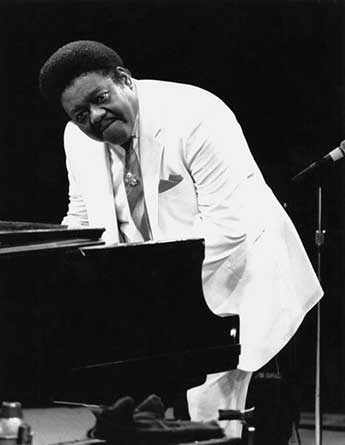
Image: Ronzoni
Basically, it’s an impossible question to answer, in part because there is no one definition of what exactly the term “Rock-and-Roll” means, or what exact song ushered in the era or began the musical genre. The phrase itself had been rolling around in several variations at least since the 1920s, and possibly even before that. Take, for instance, Trixie Smith’s remarkably saucy rendition of My Man Rocks Me (with One Steady Roll) recorded in 1922. However, Rick Coleman’s 2006 book makes the case the song that started it all should indeed be Domino’s 1949 The Fat Man, which itself was an upbeat version of Junker’s Blues, a mournful 1940 song about heroin addiction, recorded with brand new non-drug related lyrics (attributed to Fats Domino and Dave Bartholomew) coupled with a rousing rock steady backbeat and “barrelling piano triplets”. Rolling Stone magazine, of course, doesn’t agree and probably neither do proponents of Little Richard and Elvis Presley.
“His chart placings were oddly modest. His only British Top 10 success was Blueberry Hill in 1956. In the US he never topped the mainstream charts and by 1962 had no Top 20 entries. Yet in the mid-70s it was still true that, with record sales of 60 or 70 million, no one had outsold him except Elvis and the Beatles.”
– Michael Gray, The Guardian, UK, October 25, 2017
Lasting legacy, singable, danceable songs with a wide appeal
“I didn’t know who Gord Downie was, and still can’t really appreciate his genre of rock, too loud and raucous, but I do remember and still enjoy the music of another famous ‘D’ i.e. Fats Domino from the 1950s. Now that’s music you can still dance to and which is still a pleasure to listen to.”
– Mike Chapman, North Vancouver, October 29, 2017
Domino was one of the first black performers to feature on the new pop music television shows that debuted in the late 50s and early 60s appearing alongside the likes of the Everly Brothers and Buddy Holly. I well remember my sisters and brother, along with my mum, dancing our little hearts out as children growing up in the UK listening to his songs.
“Fats Domino was an iconic pianist/singer who laid down many beats for piano players and tickled the ivories like a tap dancer, running, hopping, skipping and jumping through a myriad of rhythms, always making people want to get up and dance.”
– Terry ‘Keys’ McGimpsey, Keyboardist, Westmount, October 27, 2017
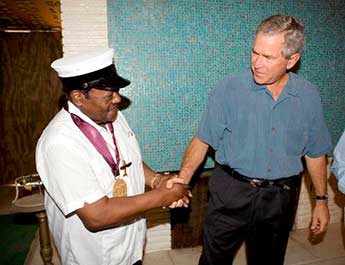
Fats Domino receiving his replacement National Medal for the Arts from President George W Bush.
Well known and beloved local pianist, Terry ‘Keys’ McGimpsey, grew up in her early years on Selby Street in Westmount, returning to look after her mother when she got ill and to spend her own retirement here. She played mostly reggae, rock and roll and jazz with many bands throughout her career as a professional keyboardist, most predominantly with Kali & Dub Inc. in the 1990s, but also with several McGill jazz combos and many other local R&B bands in the Montreal music scene as well as on various albums, leading to extensive travels throughout Canada plying her chosen trade. She credits the music of Fats Domino as being part of what fuelled her early interest in learning piano, along with the fact that at five years old she took lessons with Daisy Sweeney, older sister of jazz legend Oscar Peterson, and becoming a fixture in the Sweeney household through her friendship with the family.
“Oscar Peterson’s sister, Daisy Peterson Sweeney, was a well-known piano teacher at that time and my mother, who was her friend, wanted me to study with her because she was the best, but basically I just wanted to learn how to rock.”
– Terry ‘Keys’ McGimpsey, Keyboardist, Westmount, October 27, 2017
But as rock ’n’ roll gave way to the guitar-based pop of the Beatles and the British Invasion as well as to others in the 1960s, North American music tastes changed, and Domino’s popularity started to dwindle somewhat, so he was told to update his style, and when he refused, he was invited to appear less and less.
‘I refused to change. I had to stick to my own style that I’ve always used or it just wouldn’t be me.’
Fats Domino
His ‘style’, however, still suited home town New Orleans and the Los Vegas stages where his rhythmic rocking and rolling waltz-time ballads and pounding up-tempo sound found an audience and were seemingly appreciated. Probably the best known of his songs remains Blueberry Hill, recorded in 1955, and selected in 2005 for the Library of Congress’s National Recording Registry, which recognises songs and their singers that are worthy of preservation. Recordings selected for the National Recording Registry are those that are “culturally, historically or aesthetically important, and/or inform or reflect life in the United States”.
“Blueberry Hill was first recorded in 1940 by several artists including Gene Autry and Glenn Miller. But Domino drew on the 1949 Louis Armstrong version when he had run out of material at a session. Producer Bartholomew thought it was a terrible idea but lost the argument. Good thing, too. It ended up being Domino’s biggest hit and broadened his audience once and for all. As Carl Perkins later said, “In the white honky-tonks where I was playin’, they were punchin’ Blueberry Hill. And white cats were dancin’ to Fats Domino.” ”
– #82: 500 Greatest Songs of all time, Rolling Stone magazine, April 7, 2011
Although Blueberry Hill was originally composed as a country and western song and first sung by Gene Autry, and then Glenn Miller, with a considerably more mellow version recorded by Louis Armstrong in 1949, it was Domino’s “seductively smooth” 1956 version that he ‘adapted’ on the fly from the Armstrong version that became the most famous (apparently even in Russia since Vladimir Putin sang it at a charity gala in 2010).
Up until 1963, when he changed record labels from Imperial Records to ABC-Paramount, Domino had more than 30 Top 40 hits. He was also on the R&B charts more than 60 times. He made more than two-dozen gold records (awarded then when sales for each topped a million; however, in 1976 certification was changed, so that now the platinum certification represents sales of one million units, album or single, with the gold certification redefined to mean sales of 500,000 units, album or single).
‘Offstage, he gambled a bit, had a thing for fancy cars and jewellery and was known to cook beans in his hotel room.’
Charles M. Young, Rolling Stone magazine
Domino never liked touring though, often explaining that New Orleans was the only place where he liked the food, but after Blueberry Hill, once he became more widely known he adopted a star persona, taking his own pots and pans on tour with him along with 30 suits and 200 pairs of shoes and, of course, his collection of large diamond rings. He appeared on many of those now fabled multiple bill performances with other stars of the era, such as Paul Anka, LaVern Baker, Chuck Berry, James Brown, Eddy Cochran, the Drifters, Duane Eddy, the Everly Brothers, Buddy Holly, BB King, Jerry Lee Lewis, Frankie Lyman, etc.
“A lot of people seem to think I started this business… But rock ’n’ roll was here a long time before I came along. Nobody can sing that music like colored people. Let’s face it: I can’t sing it like Fats Domino can. I know that.”
– Elvis Presley, interview with Jet magazine, 1957
Even Elvis Presley is reported to have said, with Fats D. in the room, the title of the King of Rock and Roll should have been given to Fats Domino and not to himself.
15 famous songs recorded over 15 years by ‘Fats’ Domino 1949-1963
The Fat Man, Valley of Tears, I’m Walkin’, The Big Beat, Blueberry Hill, I’m in Love Again, I Want to Walk You Home, Be My Guest, Country Boy, Walking to New Orleans, Three Nights a Week, My Girl Josephine, It Keeps Rainin’, What a Party, Red Sails in the Sunset.
N.B.: He recorded and released many more songs during this period, these are just some of the most recognized.
The last 30 years – very much a hometown boy
In 1986, Domino was inducted in the Rock & Roll Hall of Fame, in Cleveland, Ohio. The following year, 1987, he was awarded a Lifetime Achievement Grammy, but did not leave New Orleans to collect it. In 1998, he was honoured with a National Medal for the Arts by President Clinton, the first rock’n’roll musician to be awarded such an honour, but he also declined to go to the White House to receive it, sending one of his daughters instead. He did, however, right up to 2007, when his health started to fail, continue to appear in some of the New Orleans’ blues clubs.
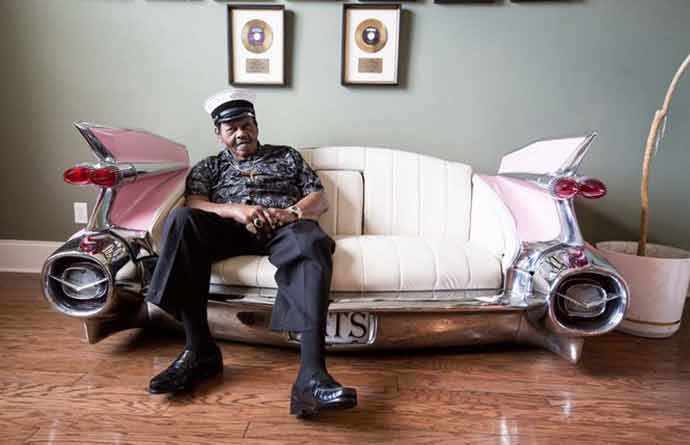
But it was New Orleans’ Lower Ninth Ward that he called home, where he lived for almost his entire life, where he had constructed his sprawling mansion, and where he held court over pots of red beans and rice. It also meant he and his family were badly affected by Hurricane Katrina, losing everything except their lives, as did many in the 9th Ward. Along with countless family treasures, memorabilia and family photos, Domino lost three pianos, several expensive cars, the famous living room couch made from the back end of a vintage Cadillac along with dozens of gold and platinum records (of which he was only able to recover three) as well as jewellery (he was definitely a big proponent of bling, bling and yet more bling, especially as regards outsized jewel encrusted finger rings and watches that apparently had simply mesmerized the young Beatles when they met him for the first time).
Lifetime sales of his songs and records now top 110 million
But the disastrous storm also gave Domino a renewed lease on life. Rolling Stone magazine named Alive and Kickin’, the new album he released a year after the storm, one of the top albums of 2006. Some consider it one of his most acclaimed works. Then, in 2007, Goin’ Home, was released, which was an all-star Domino tribute album featuring covers by well-known stars such as Herbie Hancock, Dr. John, Elton John, Norah Jones, BB King, Lenny Kravitz, John Lennon, Los Lobos, Paul McCartney, Randy Newman, Willie Nelson, Tom Petty, Robert Plant, the Preservation Hall Jazzband, Bonnie Rait, the Soweto Gospel Choir, Taj Mahal and the New Orleans Social Club, Toots and the Maytals, Allen Toussaint, Lucinda Williams, Neil Young and others.
“Other artists continued to record and perform Domino’s repertoire, and always will. He was one of the few true giants of post-war American popular music: no one sounded like him, yet ask who he influenced, and the answer is everyone.”
– Michael Gray, The Guardian, UK, October 25, 2017
After 2007, although he did not perform as such, he did appear at various benefit concerts to smile and wave right up to 2014 but sadly, he never did manage to move back home to his beloved 9th Ward house, although he was a frequent visitor to his studio/publishing house that had been rebuilt as part of the reclamation effort for re-establishing the Lower 9th Ward.
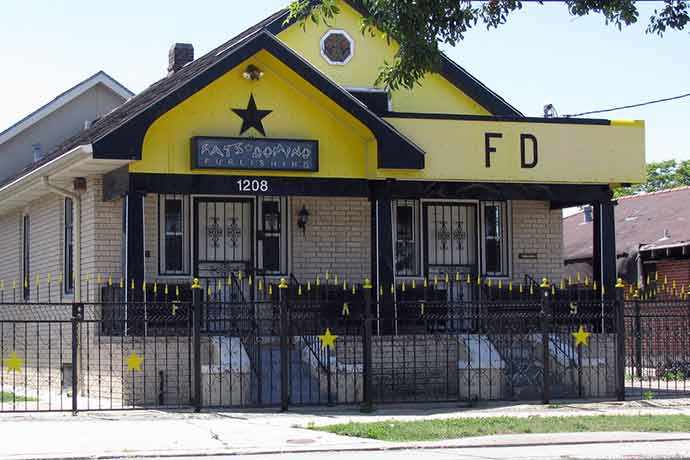
Fats Domino’s studio in the Lower 9th Ward. Image: baldeaglebluff via StockPholio.net
“He just did what Fats did”
Although success seemingly came as a surprise to Domino, who was born February 26, 1928, the youngest in a family of eight children. As a youth, after a cousin left an old upright piano in their house, he taught himself popular piano styles — blues, boogie-woogie, honky-tonk, ragtime. He credited Fats Waller and Albert Ammons as his early influences.
“I was only 17 when I made my first record in 1949,” the media-shy Domino said in a BBC interview in 1973 (which was obviously a mistake on his part, as in 1949 he would have been 21 and married. Perhaps looking back he remembered feeling like he was 17 and being somewhat overwhelmed… who knows?). He then continued: “I never thought about being a professional singer or pianist. I used to work in a lumberyard. Then I heard a piano number on a jukebox and liked it. It was called Swanee River Boogie by Albert Ammonds.”
Domino apparently went home and practised and refined Ammonds’ animated boogie-woogie keyboard style in order to create a unique sound of his own. His mastery of New Orleans R&B, Dixieland jazz, ragtime, stride piano, jellyroll, country, swing and other musical styles further distinguished him, as did his unfailing ability to evoke magical musical scenes and images in under three minutes.
‘The beauty of the Domino sound lies in the clear melodic lines, tight harmonies and that deep gorgeous voice matched by few singers today.’
Jason Berry, New Orleans Magazine, October 2007
He found a perfect creative partner in trumpeter, bandleader, arranger, songwriter and producer Dave Bartholomew, and although they parted company a few times, most notably when Domino moved to ABC-Paramount, they were reunited when Domino returned to Imperial Records.
Of his partner’s contributions to rock ‘n’ roll history, Bartholomew once said: “Fats is… just like the cornerstone… when you build a new church… you lay the cornerstone, and if the church burns down, the cornerstone is still there.”
So the legendary Fat Man’s golden baritone is now stilled, his radiant smile available only in photographs, and the curtain has come down for the final time as the world bemoans the loss of yet another rock & roll icon. His fans are legion, his influence was pervasive, his legacy long. Short in stature he might have been, but he was mighty in many other ways.
“Fats is old school to the max – he loved to work the house, do looooong shows and push the piano across the stage with his belly. That innocence is there in his music. He’s a good man, and people respond to that goodness. I don’t think it was about anything other than the tradition of working the house and what felt good to Fats.”
“When all the payola scandals were happening and it looked bad for rock & roll, Fats did an interview in some magazine. He said, “I don’t know what all the trouble is about us being a bad influence on teenagers. I’m just playing the same music I played all my life.” That’s what Fats was about. He didn’t look on what he did as special or different. He just did what Fats did.”
– #25: 100 Greatest Artists of all time, Dr John, Rolling Stone magazine, December 2, 2010
“Fats embodies everything good about New Orleans,” friend David Lind said in an interview for the 2008 PBS documentary Fats Domino: Walkin’ Back to New Orleans. “He’s warm, fun-loving, spiritual, creative and humble. You don’t get more New Orleans than that.”
“R.I.P. Fats. You will be missed”
Indeed, and this time the world mourns along with the unknown graffitist.
Read also: It’s a good life if you don’t weaken
Wanda Potrykus is a writer, editor, translator and poet. A graduate of McGill, she has spent most of her career in marketing communications, PR, event and media relations specializing in international aviation, telecommunications, education and the marketing of the arts.
info@westmountmag.ca

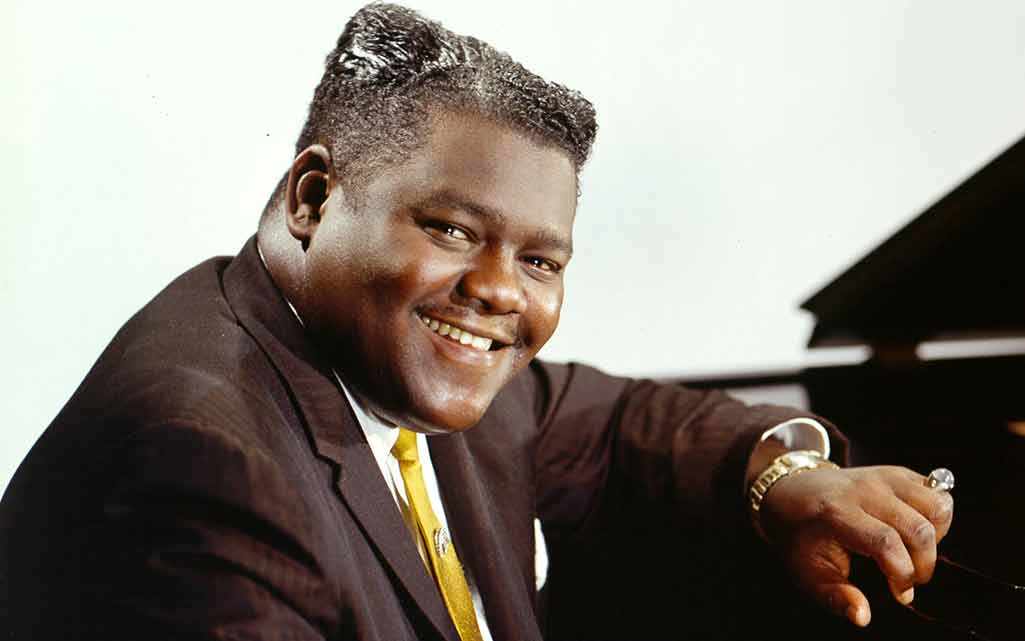






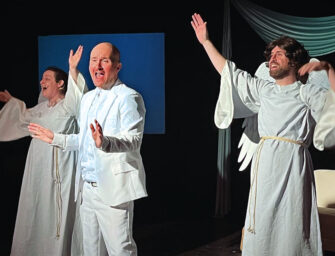







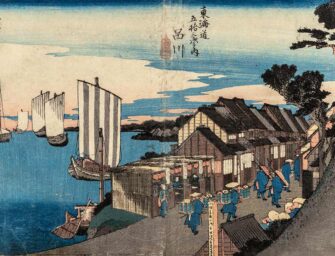

















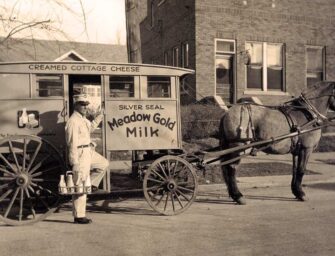


I loved Fats Domino. Fats, Little Richard, Elvis and The Everley Brothers. The soundtrack of my youth.
Pat